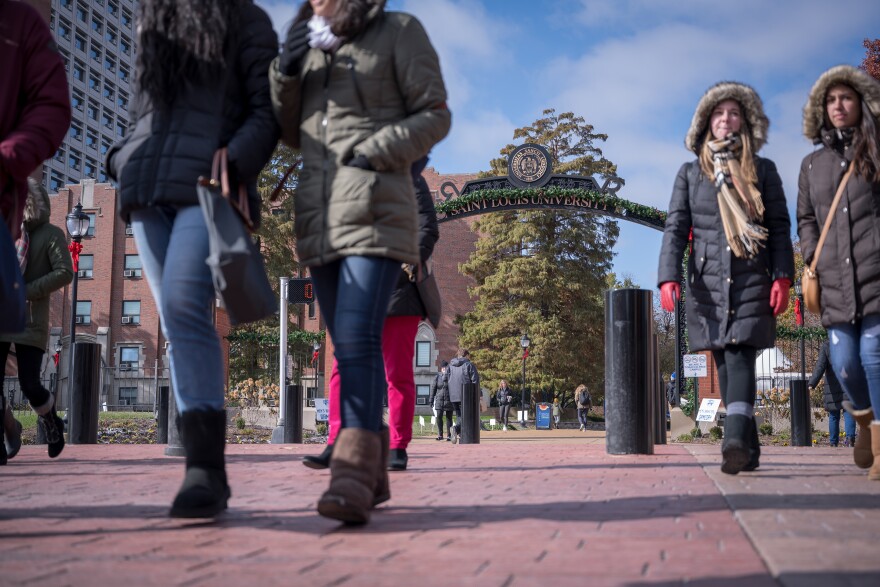Colleges in the Midwest that make it to the other side of the current higher education upheaval accelerated by the pandemic will offer fewer — and different — academic programs than they do now.
Because of a shrinking pool of traditional college students and rising costs, humanities and liberal arts majors are at risk as colleges focus on programs such as engineering and health care, which are in greater demand and generate more revenue.
“A lot of colleges are showing that they have some nimbleness still, but they're doing it by literally slashing entire academic departments,” said Michael Horn, an education industry watcher and commentator. “So a college is staying in business by cutting all of their humanities, for example.”
The impacts will be more acutely felt at smaller colleges, which live more on the margins and lack huge endowments to fall back on.
McKendree University in Lebanon, Illinois, is one of many small liberal arts colleges dotting the Midwest. Its board of trustees is considering eliminating seven academic programs, according to documents given to St. Louis Public Radio by faculty, in a review that began prior to the pandemic.
Programs on the chopping block include theater, international relations and Spanish. Meanwhile, other programs could be scaled back, including philosophy and religious studies. The university has recently launched programs in cybersecurity and data analytics.
McKendree’s student population shrunk by about 10% to 2,292 from 2013 to 2019, the most recent year of federal data available on private colleges. Meanwhile, expenses rose during that time by $6.3 million.
“Recruitment and retention, always a priority, have been made more complex by the virus’ effect on the economy and family finances, and by state-mandated restrictions on travel and face-to-face visits,” McKendree spokeswoman Lisa Sanders said in a statement, adding that in the fall the school “experienced positive enrollment growth.”
Sanders said program prioritization, as the practice is known, “is an appropriate, necessary and responsible part of the ordinary course of the higher education business and financial model.”
Smaller, rural colleges such as McKendree are most at risk, and several industry watchers predict an accelerated pace of college closures because of the pandemic. MacMurray College, 80 miles to the north in Jacksonville, announced its closure last April.
Fontbonne University, a private, Catholic institution in Clayton, has experienced fluctuating enrollment and finances in recent years as well. In 2017, it purchased the campus of the former John F. Kennedy High School in west St. Louis County for $8 million as part of a plan to increase enrollment. But the university, which currently has about 1,200 students, reversed course last spring and put the 22-acre JFK grounds back on the market, according to the St. Louis Business Journal.
Fontbonne has improved its retention and graduation rates, which to higher education financial analyst Gary Stocker means the school is “is doing something right.”
But Stocker, who runs College Viability, notes the school’s endowment has also shrunk by $5.6 million. “That’s not a positive trend,” he said.
A Fontbonne spokesman declined to comment for this story.
But the strain is reaching larger institutions as well. University of Missouri System President Mun Choi forecast an overhaul of course catalogs through program consolidation across the four-campus network during a board of trustees meeting Thursday.
The UM System will look to cut expenses in programs “that are not central to our mission,” said Choi, who has focused on academic research to grow revenue since taking over the state’s flagship university system in 2017.
“Instead of asking the question why we need to divest from programs,” he said, “we should be asking why we need to continue to invest in those programs if they are not central to our mission?”
Missouri University of Science and Technology, which is part of the UM System, is considering shedding some of its majors. The campus in Rolla focuses on science and engineering, and Chancellor Mo Dehghani said last year that some majors may "potentially sunset." The school's lowest enrollment areas are all in the humanities.
St. Louis University’s enrollment was rebounding — the incoming class in 2019 was the college’s largest ever — until the pandemic hit. Enrollment dipped again, and the university’s medical practice took a hit. SLU froze raises and retirement contributions for all employees and cut pay for top officials.
“Faculty have taken a real hit. It's been tough,” said Ruth Evans, an English professor and president of the university’s faculty senate.
The private university expects to operate with a deficit this year between $4 million and $8 million, said President Fred Pestello.
“We did some belt tightening. We had to, and it's the responsible thing to do in terms of keeping this affordable for our students,” Pestello said.
SLU has gone through two rounds of staff layoffs as well as other cuts in the past five years. And it’s in the middle of a substantial review of its academic offerings, which could result in eliminating tenured faculty positions, depending on the scale of the reorganizing.
SLU had an extra-thick course catalog compared to similar colleges when Pestello arrived in 2015, he said. The current program review process isn’t expected to be completed until next year, but Pestello said the college will try to balance investment in in-demand majors with its core mission as a Catholic school.
“Humanities, particularly philosophy and theology, are central and must be central,” Pestello said. “That said, you have to balance where student interest and demand is.”
Follow Ryan on Twitter: @rpatrickdelaney
Correction: An earlier version of this story mistakenly indicated that Missouri S&T has already determined which majors it will cut. It has not.





